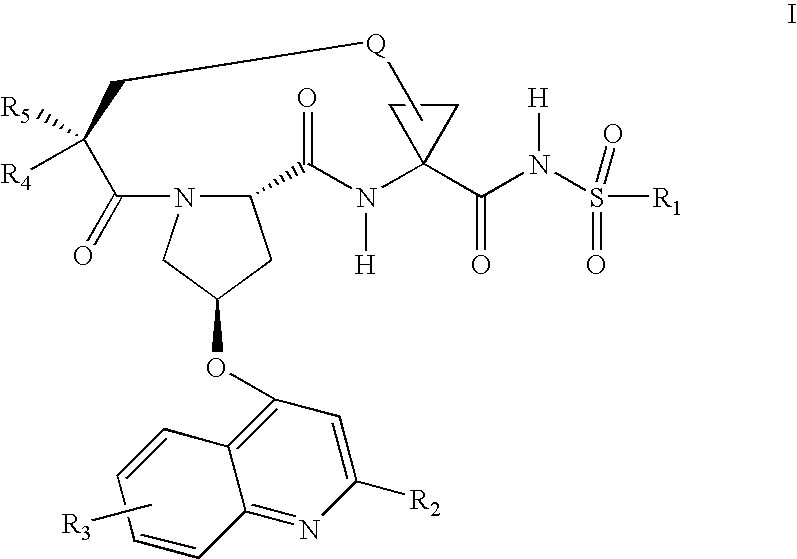Inhibitors of hepatitis C virus
a technology of hepatitis c virus and inhibitors, which is applied in the direction of peptides, drug compositions, peptides, etc., can solve the problems of sustained response rate and not alleviating the ifn-induced side effects
- Summary
- Abstract
- Description
- Claims
- Application Information
AI Technical Summary
Benefits of technology
Problems solved by technology
Method used
Image
Examples
example 1
Step 1a: Preparation of 4-hydroxy-2-phenyl-7-methoxy-quinoline
To a solution of m-anisidine (300 g, 2.44 mole) and ethyl benzoylacetate (234.2 g, 1.22 mole) in toluene (2.0 L) was added HCl (4.0 N in dioxane, 12.2 mL, 48.8 mmole). The resulting solution was refluxed for 6.5 hr using a Dean-Stark apparatus (about 56 ml of aqueous solution was collected). The mixture was cooled to rt, partitioned multiple times with aqueous HCl (10%, 3×500 mL), aqueous NaOH (1.0 N, 2×200 mL), water (3×200 mL), and the organic layer dried (MgSO4) and concentrated in vacuo to supply an oily residue (329.5 g). The crude product was heated in an oil bath (280° C.) for 80 min using a Dean-Stark apparatus (about 85 mL liquid was collected). The reaction mixture was cooled down to rt, the solid residue triturated with CH2Cl2 (400 mL), the resulting suspension filtered, and the filter cake washed with more CH2Cl2 (2×150 mL). The resulting solid was dried in vacuo (50° C.; 1 torr; 1 day) affording analytically...
examples 1 , 2
EXAMPLES 1,2
Preparation of Compounds 1 and 2
Step 1g: Preparation of 1-{[1-(2(S)-tert-butoxycarbonyl-amino-hex-5-enoyl)-4-(7-methoxy-2-phenyl-quinolin-4(R)-yloxy)pyrrolidine-2(S)-carbonyl]-1(R)-amino]-2(S)-vinylcyclopropanecarboxylic acid ethyl ester
To suspension of (0.600 g; 1.04 mmol) of 1-{[4-(7-Methoxy-2-phenylquinolin-4(R)-yloxy) pyrrolidine-2(S)-carbonyl]-1(R)-amino}-2(S)-vinylcyclopropanecarboxylic acid ethyl ester, dihydrochloride, 2(S)-tert-butoxycarbonyl-amino-5-hexenoic acid purchased from RSP Amino Acids (0.34 g, 1.46 mmol), NMM (0.57 ml, 5.22 mmol) in DMF (5 mL) was added HATU (0.56 g, 1.46 mmol) at 0° C. After being stirred for 2 days, the reaction mixture was diluted with EtOAc (200 mL), washed with pH 4.0 buffer (2×30 mL), saturated aqueous NaHCO3 (30 mL), brine (30 mL), dried (MgSO4), purified by a Biotage 40 M column (eluted with 30% to 60% EtOAc in Hexanes) to supply the titled compound, 1-{[1-(2(S)-tert-butoxycarbonylamino-hex-5-enoyl)-4-(7-methoxy-2-phenyl-quino...
examples 3 , 4
EXAMPLES 3,4
Preparation of Compounds 3 and 4
Step 3g: Preparation of 1-{[1-(2(S)-tert-butoxycarbonylamino-hept-6-enoyl)-4-(7-methoxy-2-phenylquinolin-4(R)-yloxy)pyrrolidine-2(S)-carbonyl]-1(R)-amino]-2(S)-vinylcyclopropanecarboxylic acid ethyl ester
Following the procedure of Step 1 g, except that (0.356 g, 1.46 mmol) of 2(S)-tert-butoxycarbonylamino-6-heptenoic acid purchased from RSP Amino Acids, was coupled in place of 2(S)-tert-butoxycarbonylamino-5-hexenoic acid, to give the titled compound, 1-{[1-(2(S)-tert-butoxycarbonylamino-hept-6-enoyl)-4-(7-methoxy-2-phenylquinolin-4(R)-yloxy)pyrrolidine-2(S)-carbonyl]-1(R)-amino]-2(S)-vinylcyclopropanecarboxylic acid ethyl ester as a yellow oil (0.600 g, 79%): 1H NMR (CDCl3) δ (300 MHz, CDCl3); 1.21 (t, J=7 Hz, 3H), 1.40 (s, 9H), 1.42-2.18 (m, 9H), 2.36-2.45 (m, 1H), 2.91-2.99 (m, 1H), 3.94 (s, 3H), 4.05-4.22 (m, 2H), 4.26-4.30 (m, 1H), 4.39-4.49 (m, 1H), 4.83 (dd, J=8.2, 5.6 Hz, 1H),4.92-5.14 (m, 4H), 5.29 (dd, J=17.2, 1.4 Hz, 1H), 5.41 ...
PUM
 Login to View More
Login to View More Abstract
Description
Claims
Application Information
 Login to View More
Login to View More - R&D
- Intellectual Property
- Life Sciences
- Materials
- Tech Scout
- Unparalleled Data Quality
- Higher Quality Content
- 60% Fewer Hallucinations
Browse by: Latest US Patents, China's latest patents, Technical Efficacy Thesaurus, Application Domain, Technology Topic, Popular Technical Reports.
© 2025 PatSnap. All rights reserved.Legal|Privacy policy|Modern Slavery Act Transparency Statement|Sitemap|About US| Contact US: help@patsnap.com



